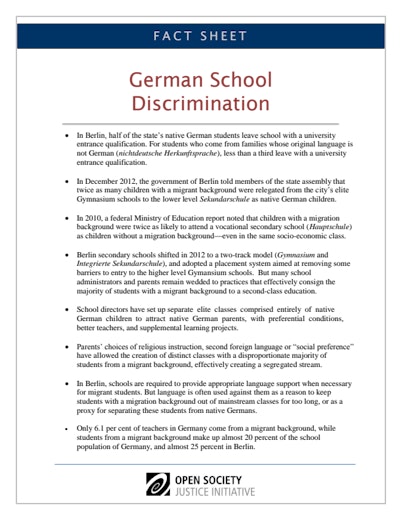Discrimination in German Schools
In Berlin, half of the state’s native German students leave school with a university entrance qualification. For students who come from families whose original language is not German (nichtdeutsche Herkunftsprache), less than a third leave with a university entrance qualification.
In December 2012, the government of Berlin told members of the state assembly that twice as many children with a migrant background were relegated from the city’s elite Gymnasium schools to the lower level Sekundarschule as native German children.
In 2010, a federal Ministry of Education report noted that children with a migration background were twice as likely to attend a vocational secondary school (Hauptschule) as children without a migration background—even in the same socio-economic class.
Berlin secondary schools shifted in 2012 to a two-track model (Gymnasium and Integrierte Sekundarschule), and adopted a placement system aimed at removing some barriers to entry to the higher level Gymansium schools. But many school administrators and parents remain wedded to practices that effectively consign the majority of students with a migrant background to a second-class education.
School directors have set up separate elite classes comprised entirely of native German children to attract native German parents, with preferential conditions, better teachers, and supplemental learning projects.
Parents’ choices of religious instruction, second foreign language or “social preference” have allowed the creation of distinct classes with a disproportionate majority of students from a migrant background, effectively creating a segregated stream.
In Berlin, schools are required to provide appropriate language support when necessary for migrant students. But language is often used against them as a reason to keep students with a migration background out of mainstream classes for too long, or as a proxy for separating these students from native Germans.
Only 6.1 per cent of teachers in Germany come from a migrant background, while students from a migrant background make up almost 20 percent of the school population of Germany, and almost 25 percent in Berlin.
Topics
- Climate Justice
- Digital Rights and Fair Elections
- Discrimination and Racial Justice
- International Crimes
